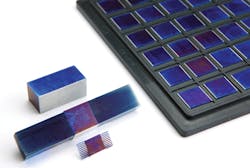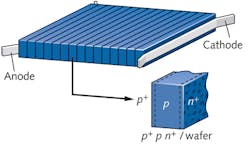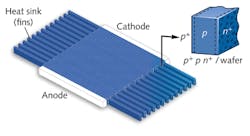Laser-Powered Devices: High-concentration PV cell enables high-wattage laser power transmission
MICO PERALES
Laser power transmission involves the transmission of power from a laser source either through free space (power beaming or PB) or via a fiber-optic cable (power over fiber or PoF) to a photovoltaic (PV) receiver. The PV receiver includes a PV cell, or an array of PV cells, optimized to convert a specific laser wavelength to electricity at high efficiencies, typically in the range of 30% to near 50%. Some uses include remotely powering unmanned aerial vehicles (UAVs), robotic devices, and hazardous environment or remote sensor applications.
MH GoPower (MHGP) produces a high-performance silicon-based vertical multijunction (VMJ) PV cell that enables high-wattage laser power transmission. The 3D design of the VMJ PV cell manages heat during high-wattage laser power transmission through the use of the bulk property of silicon, which includes fins integrated into the device. Here, we explore the applications and value proposition of free-space PB and PoF, as well as review the technology behind the high-performance VMJ PV cell.
Why power beaming?
When compared to battery-derived power, the advantages of free-space PB include increased operating time, a reduction or elimination of recharging events, and a potential reduction in weight. We illustrate these advantages by examining the UAV application. The flight time of a UAV can be extended in theory to indefinite duration, so long as the power beamed to the PV receiver on the UAV and converted to electricity exceeds the power usage.
By extending flight time, the need for the operationally sensitive and technically risky maneuver of landing for recharging is reduced. Also, if extended flight duration is required, rather than attaching additional batteries and adding weight to the UAV, a lighter-weight PV receiver can be deployed to achieve the extended-duration requirements; this may also allow for additional payload capacity.
Why power over fiber?
There are several advantages of sending power over fiber rather than through copper. Power delivery through copper is susceptible to RF and magnetic field interference, which can result in power surges or other signal anomalies that can damage equipment, making systems unreliable. Furthermore, copper wiring serves as a ground path for lightning strikes and can induce sparks in high voltage or poorly insulated environments. Power by laser light suffers none of these problems.
Some examples of applications that benefit from these advantages include sensors and other devices operating in hazardous, explosive, or high-voltage environments (current sensors), devices exposed to harsh weather such as lightning (outdoor video surveillance cameras as an example), and devices requiring noise immunity (medical monitoring equipment and military applications).
Barriers to market acceptance
Laser power transmission applications have been primarily limited by system costs. The metric for these costs is cost per watt of delivered electrical power. Driven by shrinking device sizes and improved efficiencies, costs per watt for laser systems have been coming down dramatically and are expected to continue declining. However, lasers are only part of the cost of a laser power transmission solution. Other key components are the fiber (for PoF), the optics, and the PV receiver (cell array) subsystems.
The optics for PoF is a small part of the overall system cost. However, for free-space PB, the focusing optics cost increases as the application distance increases due to an increase in lens size. As a result, optics costs can quickly dominate the free-space PB system costs, and thus become the limiting factor on the practical range. Still, ranges of a few kilometers are economically and technically viable. Similarly, for PoF applications, the cost of the fiber begins to dominate costs over longer distances, generally limiting practical applications to a few kilometers.
Finally, PV receiver power density can play a significant factor in the viability of the laser power transmission solution. In order to ultimately reduce system costs, higher receiver power densities are required, and this can be achieved in two ways: 1) by increasing the power of the laser, thus increasing the intensity of light on the PV receiver; or 2) by increasing the efficiency of the PV receiver.
In the first scenario, the increased power of the laser results in a lower incremental cost per watt-up to a point. For example, in a free-space UAV application, the tracking hardware and software, laser mounting hardware, optics, UAV, and receiver size are all fixed, and thus an increase in the laser power does not increase the cost of these systems. In fact, it could mean that smaller batteries are needed, further reducing the incremental cost of adding this additional power. Consequently, as long as the PV receiver can perform well in the increased intensity laser light and can manage the heat, it is advantageous to increase the power of the laser source (the analysis similarly holds true for a PoF application).
In the second scenario, improving PV receiver efficiency results in more power output for a given PV receiver footprint and balance of system costs. Alternatively, it allows for the use of a lower-power and lower-cost laser system. A more-efficient PV receiver also means that there is less waste energy to dissipate, with the result that cells will operate cooler (a positive performance feedback loop) or that a lower-cost and often lower-weight heat sink can be used. Another advantage of more-efficient PV receivers is that the overall system efficiency will be enhanced, which is important for some applications in terms of both cost and system operation.
How the VMJ PV cell achieves high power density
The MHGP silicon-based VMJ PV cell (VMJ cell) is a cost-competitive concentrating PV cell, which works most effectively with laser systems with wavelengths in the 900 to 1000 nm range. The VMJ cell's material composition and device structure serve as the foundation of the cell's competitiveness for laser power transmission applications.
The VMJ cell is an integrally bonded series-connected array of miniature silicon vertical-junction unit cells. The VMJ cell is fabricated by bonding a stack of diffused and metalized silicon wafers together and then dicing the stack into thin slices, resulting in high-voltage, low-current cells that each contain approximately 50 unit cells (junctions) per centimeter of length, resulting in near 30 V/cm. Electrical leads are attached to the end contacts, so that current flows from the ends of the cells (see Fig. 1).Increasing intensity on conventional PV cells will increase output to a point. Gallium arsenide (GaAs) concentrating PV cells designed for laser light conversion require dense grid lines on the front and back surface of the cell to manage higher concentrations of light. This has the effect of reducing cell performance as intensities go up. The MHGP VMJ cell has been shown to maintain constant performance in efficiency (based on flash test results) up to intensities greater than 100 W/cm2.
The major challenge for PV cells under highly concentrated light is managing the waste thermal energy. As intensities increase, cell temperatures rise, resulting in lower performance, which results in still proportionally greater waste energy. In other words, high intensities have a compound negative impact on cell performance.
The barrier to efficiently removing heat from PV arrays is the thermal interface layer (TIM), which bonds the PV cells onto the thermally conductive heat sink. Typically, this TIM must utilize a thermally conductive, yet electrically insulating material to prevent the current-carrying, electrically active cell surfaces or leads from shorting. As such, these TIM materials are typically not ideal thermal conductors. The result is that a barrier exists to heat transfer, resulting in a limit to the rate of heat transfer away from the PV cell.
To improve heat dissipation, we have incorporated a number of innovations into our VMJ cell and receiver designs, including: a) thick cell architectures (up to 1 cm thick); b) end-contact heat dissipation; and c) embedded heat-sinking structures in the PV device. In combination, these features enable some novel heat-dissipation solutions.
As an example, thick VMJ cells with integrated "fins" (called WiFins; see Fig. 2) improve heat-sinking by increasing the cell's surface area for radiant and/or convective cooling, allowing heat to be dissipated without having to pass through the TIM bottleneck. Thick VMJ cells with metalized end contacts use a metallic, bonding material with high thermal conductivity to attach the large-surface-area end contacts to an electrically conductive heat sink, which doubles as the device's anode and cathode. These innovations enable the VMJ cell to more effectively dissipate heat, leading to higher-intensity power operation.PV receiver efficiency
Finally, the MGHP VMJ cell also improves PV receiver efficiency. This is accomplished through the VMJ cell's customizable size (up to 7 x 7 cm in width/length) and high voltage characteristics. The customizable size allows the cell to be matched in size to the expected spatial nonuniformity of the application. In other words, a highly spatially nonuniform beam pattern would require smaller cells, which would be paralleled together, avoiding series losses. A beam pattern that varies more slowly spatially would allow for larger cells, again paralleled together.
This completely parallel architecture is viable due to the high-voltage nature of the VMJ cell, which along with the customizable cell size, allows the PV array to easily approximate the voltage requirements of the end application, thus helping to reduce the costs, inefficiencies, and additional weight requirements of step-up converters.
The benefits of delivering power via fiber or through free-space are spurring the growth of new applications. To further accelerate the adoption of these applications, additional system cost reductions must be achieved. This will continue to occur due to the expected drop in laser prices, but can be further spurred by the incorporation of the MHGP VMJ cell into PV receiver designs, resulting in greater PV receiver power densities that will further lower laser power transmission system costs.
Mico Perales is business development manager at MH GoPower Co. Ltd., Kaohsiung, Taiwan; email: [email protected]; www.mhgopower.com.


